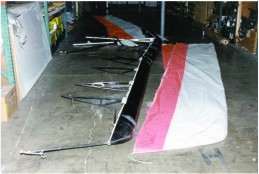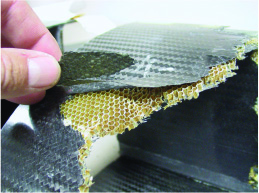Hang Glider Crash

Figure 1. Right-side wing of hang glider with wing cloth removed exposing main box spar and folding ribs
Figure 2. Delamination of outer face sheet of box spar |
A rigid-wing hang glider was being piloted near Point of the Mountain, Utah when it suffered a catastrophic in-flight failure and crashed. The pilot sustained serious injuries but survived. An accident investigation found that the main wing spar completely fractured in two locations: one on the left wing 48 inches outboard of the aircraft centerline, and one on the right wing 83 inches outboard of the aircraft centerline.
The primary structural component of the hang glider rigid wing is a D-shaped carbon-fiber-reinforced polymer face sheet, honeycomb sandwich structure, cantilever box spar. The wing ribs are attached to the spar and hinge outward into place for assembly of the fabric covered wing prior to flight. The wing fabric is draped around the spar and ribs, and it is tightened into place with Velcro and lines to the ribs. Figure 1 shows the hang glider with the wing fabric removed from the right-side wing.
The location of the left side spar fracture was congruent with the swing distance of the transom corner. This geometric match, coupled with a buckled left side transom bar, indicated that the left-side spar fracture was caused by impact with the transom at the time of contact with the ground.
The location of the right-side spar fracture is much further outboard than the swing distance of the transom, and therefore appears to be unrelated to transom contact. Furthermore, the fracture here is angled suggesting that the primary loading at the time of the failure was torsional in nature.
Figure 2 shows an area of the outer face sheet at the right-side spar fracture which was found delaminated. There is a lack of adhesive bonding between the carbon fiber sheet and the Aramid honeycomb core. A properly bonded face sheet that was separated from the core material would exhibit either fractured honeycomb material or significant pullouts from the face sheet with corresponding exposed fibers. The lack of such evidence in this area indicates that the bond strength was poor at best.
This evidence indicates that the right-side spar suffered a torsion failure during flight when the torsion load exceeded the strength of the delaminated composite sandwich structure. The torsion failure resulted in the complete in-flight fracture of the right-side spar.

